Pumpkin Bread: A healthy food to start your day !
The bread
The pumpkin is a vegetable that needs little introduction, as most of us would have probably eaten it stir-fried, in pies, cakes and soups, or relished the seeds for snacks. In some parts of Asia, the young shoots of this plant is also harvested and stir fried. Thus the pumpkin is a very versatile fruit culinary wise.
We will now share with you how pumpkin can be used to flavour bread. For a start, we have chosen the Chinese Pumpkin (Cucurbita moschata) as it is available in most markets in Singapore, and the flesh also imparts a lovely orange tinge and a delicate sweetness to the bread. The sugars already present in the fruit also means that you can use less-refined sugar in this recipe, thus qualifying it as a healthy variation to white bread. So if you love to bake - do try out this recipe!
And the rich orange colour also makes it perfect for serving to guests on special occasions, such as the Lunar New Year!
The vine
The Chinese Pumpkin is a rather attractive vine with large, dark-green leaves and bright yellow flowers. As a large vine, this species will do well when allowed to 'sprawl' on a raised bed in garden plots, or trained onto a trellis.
Generally, it takes about three to four months for a vine (grown from seed) to start producing flowers and fruits, but this period may vary depending on the growing conditions provided. The flowers are pollinated by bees, and mature pumpkins can be harvested in about 40 days after pollination.
To grow the vine, simply collect the seeds from the ripe pumpkins, or purchase seed packets from retail nurseries. Under local conditions, the Chinese Pumpkin is best grown under full sun (with at least four - six hours of sunlight using a fertile, loamy, well-drained soil mix. Plants prefer to be well watered, and the soil should be kept moist. To encourage general well-being of the plant and flower and fruit production, feeding the plant regularly (once every week or every 2 weeks) using a mix of good compost and fertilisers is recommended.
And the recipe!
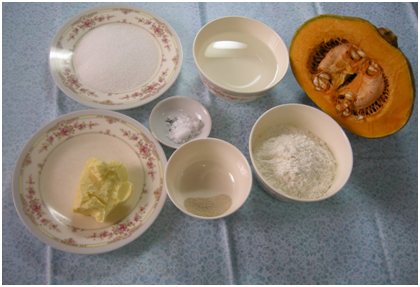
Ingredients (from left to right) : sugar, water, pumpkin, butter, salt, yeast and bread flour.
Ingredients A
100g pumpkin puree or œ of a medium sized pumpkin
90ml water
250g bread flour
1tea spoon yeast
30g white sugar
œ tea spoon salt
Ingredient B
20g butter
Steps
1. Making the pumpkin puree
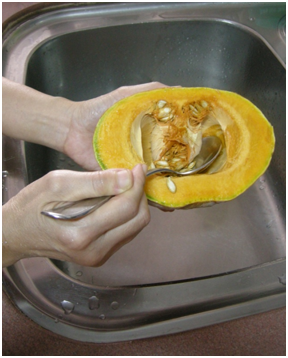
Scoop out the seeds from one half of the pumpkin
1a. Cut the pumpkin in half and remove all the seeds
1b. Place the halved pumpkin into a pot with about an inch depth of water. Cook using high heat until the water boils, and allow to simmer for 14minutes. The pumpkin is ready to be used when a fork can be inserted into its flesh with relative ease.
1c. Remove the pumpkin and carve about 100g of pumpkin flesh from the rind. Mash and set aside.
2. Making the dough
2a. Pour all ingredients under 'A' into the mixing bowl and mix thoroughly until the mixture has a dough-like texture.
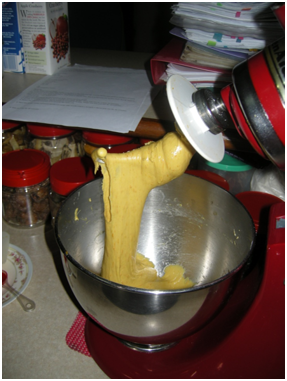
Mixing the ingredients together.
2b. Next, add butter into the mixture and continue to mix until the dough achieves a smooth and elastic texture.
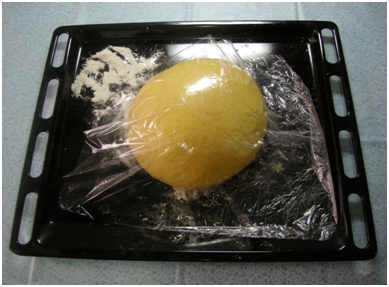
Letting the dough rest for it to expand later.
2c. Leave the dough to rest for an hour before removing it from the mixing bowl. Shape the dough into a ball and cover it with a piece of cling wrap,and allow it to rest at room temperature for another hour in order for the dough to expand.
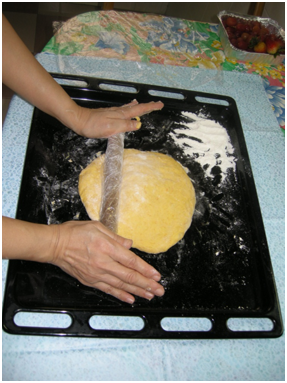
Flattening the dough to remove air bubbles.
2d. Remove the cling wrap from the dough, knead and flatten it to remove the air bubbles and mold it into the shape of a swiss roll. Place the dough in a greased loaf tin and allow it to rest for another hour.
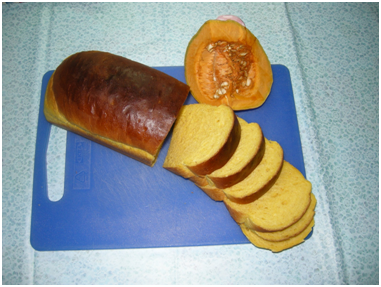
The finished product!
2e. Pre-heat the oven at 180°C for 5 minutes, then place the loaf tin into the oven and bake at 180°C for 15 minutes. You now have your pumpkin loaf !
By Charis Chiang





Have views or comments on this article? Let us know via this form. If you would like to give us feedback on any other areas relating to our parks and gardens, please submit via https://www.nparks.gov.sg/feedback